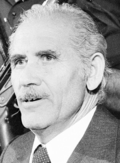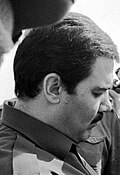List of heads of state of Afghanistan
This article lists the heads of state of Afghanistan since the foundation of the first Afghan state, the Hotak Empire, in 1709.
List of heads of state
(Dates in italics indicate de facto continuation of office)
Monarchs
| Monarch of Afghanistan | |
|---|---|
| Former Monarchy | |

| |
| Royal Standard (1931–1973) | |

| |
| Last to reign: Mohammed Zahir Shah 8 November 1933 – 17 July 1973 | |
| First monarch | Mirwais Hotak (Emir) |
| Last monarch | Mohammed Zahir Shah (King) |
| Official residence | Kabul:
|
| Appointer | Hereditary |
| Monarchy started | {{{began}}} |
| Monarchy ended | {{{ended}}} |
| Current pretender | Ahmad Shah Khan, Crown Prince of Afghanistan |
Hotak Empire (1709–1738) Lua error in package.lua at line 80: module 'Module:Succession table monarch/messages' not found.
Durrani Empire (1747–1823) Lua error in package.lua at line 80: module 'Module:Succession table monarch/messages' not found.
Emirate of Afghanistan (1823–1926) Lua error in package.lua at line 80: module 'Module:Succession table monarch/messages' not found.
Kingdom of Afghanistan (1926–1929) Lua error in package.lua at line 80: module 'Module:Succession table monarch/messages' not found.
Saqqawist Emirate and the 1928–1929 civil war Lua error in package.lua at line 80: module 'Module:Succession table monarch/messages' not found.
Kingdom of Afghanistan (restored; 1929–1973) Lua error in package.lua at line 80: module 'Module:Succession table monarch/messages' not found.
Local monarchs
Some rulers tried to take advantage of internal conflicts in Afghanistan to claim the throne. However, their rule was limited only to certain areas.
Lua error in package.lua at line 80: module 'Module:Succession table monarch/messages' not found.
List
| Name | Portrait | Lifespan | Term of office | Political party | |||
|---|---|---|---|---|---|---|---|
| Took office | Left office | Time in office | |||||
| Republic of Afghanistan (1973–1978) | |||||||
| Mohammed Daoud Khan | 
|
1909–1978 | 17 July 1973 | 28 April 1978 | 4 years, 285 days | Independent (until 1976) | |
| National Revolutionary Party | |||||||
| President; Member of the Barakzai dynasty (first cousin of Mohammed Zahir Shah); Assassinated with most of his family during the Saur Revolution.[1] Shortly afterwards, the new military leaders announced that Khan was killed for refusing to surrender.[2] | |||||||
| Democratic Republic of Afghanistan (1978–1992) | |||||||
| Colonel Abdul Qadir |

|
1944–2014 | 28 April 1978 | 30 April 1978 | 2 days | People's Democratic Party (Khalq faction) | |
| Chairman of the Presidium of the Military Revolutionary Council | |||||||
| Nur Muhammad Taraki | 
|
1917–1979 | 30 April 1978 | 14 September 1979 | 1 year, 137 days | People's Democratic Party (Khalq faction) | |
| Chairman of the Presidium of the Revolutionary Council; Assassinated by orders of Hafizullah Amin | |||||||
| Hafizullah Amin | 1929–1979 | 14 September 1979 | 27 December 1979 | 104 days | People's Democratic Party (Khalq faction) | ||
| Chairman of the Presidium of the Revolutionary Council; Assassinated by Soviet special forces during the Operation Storm-333[3] | |||||||
| Babrak Karmal | 
|
1929–1996 | 27 December 1979 | 24 November 1986 | 6 years, 332 days | People's Democratic Party (Parcham faction) | |
| Chairman of the Presidium of the Revolutionary Council; Dismissed | |||||||
| Haji Mohammad Chamkani | 
|
1947–2012 | 24 November 1986 | 30 September 1987 | 310 days | Independent | |
| Chairman of the Presidium of the Revolutionary Council; Appointed as part of the National Reconciliation process | |||||||
| Mohammad Najibullah | 
|
1947–1996 | 30 September 1987 | 16 April 1992 | 4 years, 199 days | People's Democratic Party (Parcham faction) (until 1990) | |
| Homeland Party | |||||||
| President (Chairman of the Presidium of the Revolutionary Council until 30 November 1987); Resigned | |||||||
| Abdul Rahim Hatif | 
|
1926–2013 | 16 April 1992 | 28 April 1992 | 12 days | Homeland Party | |
| Acting President; Deposed | |||||||
| Islamic State of Afghanistan (1992–2002) | |||||||
| Sibghatullah Mojaddedi | 
|
1926–2019 | 28 April 1992 | 28 June 1992 | 61 days | National Liberation Front of Afghanistan | |
| Acting President; Resigned | |||||||
| Burhanuddin Rabbani | 
|
1940–2011 | 28 June 1992 | 22 December 2001 | 9 years, 167 days | Jamiat-e Islami | |
| President; Between 1996 and 2001, the Islamic State remained the internationally recognized government, despite only controlling about 10% of Afghan territory | |||||||
| Hamid Karzai | 
|
born 1957 | 22 December 2001 | 13 July 2002 | 203 days | Independent | |
| Acting President | |||||||
| Islamic Emirate of Afghanistan (1996–2001) | |||||||
| Mullah Mohammed Omar |
1960–2013 | 27 September 1996 | 13 November 2001 | 5 years, 47 days | Taliban | ||
| Head of the Supreme Council, Emir and Commander of the Faithful; The Islamic Emirate never attained widespread international recognition, despite controlling about 90% of Afghan territory; Deposed | |||||||
| Mullah Mohammad Rabbani |

|
1955–2001 | 27 September 1996 | 13 April 2001 | 4 years, 198 days | Taliban | |
| Prime Minister and Deputy Head of the Supreme Council; Deputy leader of the Taliban; Died in office | |||||||
| Mawlawi Abdul Kabir |

|
born 1958 | 16 April 2001 | 13 November 2001 | 211 days | Taliban | |
| Acting Prime Minister and Acting Deputy Head of the Supreme Council; Deposed | |||||||
| Transitional Islamic State of Afghanistan (2002–2004) | |||||||
| Hamid Karzai | 
|
born 1957 | 13 July 2002 | 7 December 2004 | 2 years, 147 days | Independent | |
| Transitional President; Appointed at the 2002 loya jirga | |||||||
| Islamic Republic of Afghanistan (2004–2021) | |||||||
| Hamid Karzai | 
|
born 1957 | 7 December 2004 | 29 September 2014 | 9 years, 296 days | Independent | |
| President; First democratically elected head of state; Elected in 2004 and re-elected in 2009 | |||||||
| Ashraf Ghani | 
|
born 1949 | 29 September 2014 | 15 August 2021 | 6 years, 320 days | Independent | |
| President; First peaceful transition of power; Elected in 2014 and re-elected in 2019; Deposed | |||||||
| Amrullah Saleh | 
|
born 1972 | 17 August 2021 | Incumbent | 4 years, 128 days | Basej-e Milli | |
| Former First Vice President; Claimed the position of caretaker president based on Article 67 of the 2004 Constitution;[4] Announced the formation of an anti-Taliban front in Panjshir[5] | |||||||
| Islamic Emirate of Afghanistan (2021–present) | |||||||
| Mawlawi Hibatullah Akhundzada |
born 1961 | 15 August 2021 | Incumbent | 4 years, 130 days | Taliban | ||
| Emir and Commander of the Faithful; The Islamic Emirate is currently not internationally recognized, despite controlling the majority of Afghan territory | |||||||
List Of Heads Of State Of Afghanistan Media
References
- ↑ "There was, therefore, little to hinder the assault mounted by the rebel 4th Armored Brigade, led by Major Mohammad Aslam Watanjar, who had also been prominent in Daoud's own coup five years before. Watanjar first secured the airport, where the other coup leader, Colonel Abdul Qadir, left by helicopter for the Bagram air base. There he took charge and organized air strikes on the presidential palace, where Daoud and the presidential guard were conducting a desperate defense. Fighting continued the whole day and into the night, when the defenders were finally overwhelmed. Daoud and almost all of his family members, including women and children, died in the fighting. Altogether there were possibly as many as two thousand fatalities, both military and civilian." p. 88 of Ewans, Martin (2002) Afghanistan: A Short History of Its People and Politics HarperCollins, New York, Page 88 ISBN 0-06-050507-9
- ↑ "1978: Afghan coup rebels claim victory". April 29, 1978 – via news.bbc.co.uk.
- ↑ "How Soviet troops stormed Kabul palace". BBC. 27 December 2009. Retrieved 3 August 2021.
- ↑ Landay, Jonathan; Macfie, Nick; Boyle, John (17 August 2021). "Afghan vice president says he is "caretaker" president". Reuters. https://www.reuters.com/world/india/afghan-vice-president-says-he-is-caretaker-president-2021-08-17/. Retrieved 17 August 2021.
- ↑ "An anti-Taliban front forming in Panjshir? Ex top spy Saleh, son of 'Lion of Panjshir' meet at citadel". The Week. Retrieved 2021-08-17.
- Notes
